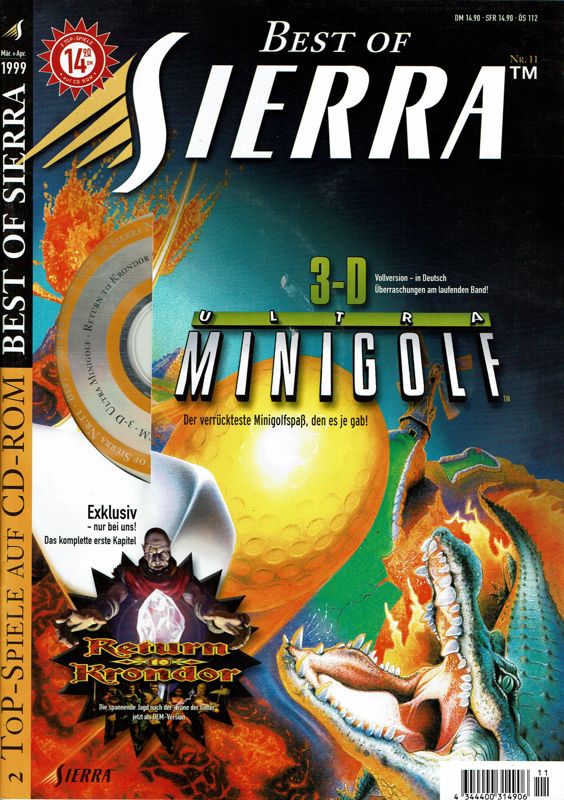Retro Replay Review
Gameplay
Best of Sierra Nr. 11 delivers a diverse gameplay package that caters to both quick-play aficionados and immersive RPG enthusiasts. On one side, 3-D Ultra Minigolf offers straightforward, pick-up-and-play levels with a charming physics engine, deft obstacle design and an accessible club-and-ball control scheme. Players can hop right in, choose from multiple courses and fine-tune their putt strength and angle for satisfying trick shots. Although its gameplay loop is inherently casual, the inclusion of hazards and environmental transitions keeps each hole fresh and challenging.
On the other end of the spectrum sits the exclusive first chapter of Return to Krondor, a true spiritual successor to the acclaimed Betrayal at Krondor. Here, intricate character management, turn-based skirmishes and branching dialogue give players a deeper strategic playground. Combat encounters demand attention to party composition, skill progressions and party positioning, while exploration sequences reward careful mapping and puzzle solving. The learning curve is steeper than in the minigolf title, but the payoff in terms of tactical depth and worldbuilding is substantial.
Beyond the two headlining titles, the accompanying magazine section enriches the gameplay experience further. A comprehensive walkthrough for 3-D Ultra Minigolf guides newcomers through tricky course layouts while preserving room for personal experimentation. Likewise, the two-page walkthrough and full-size Midkemia map for Return to Krondor ensure that players never feel stranded in chapter one’s winding corridors. These editorial features not only bridge potential frustration gaps but also serve as a testament to Sierra’s commitment to player support.
Graphics
Released in early 1999, 3-D Ultra Minigolf still impresses with its bright, cartoon-infused visuals and crisp course geometry. Each hole is rendered in a clean isometric perspective, with clear ball shading and dynamic flag animations that convey a pleasing sense of depth. While the textures lack high-resolution polish by modern standards, they remain colorful and lively, ensuring each new course unfolds as a small micro-arena of delightful design.
Return to Krondor adopts a palette and presentation that befit its epic fantasy setting. Character portraits are hand-painted with rich detail, and in-game tilesets capture medieval corridors, tavern interiors and forest glades with convincing atmosphere. Though the 2D backgrounds and sprite-based creatures may seem dated today, they retain a nostalgic charm and allow for smoother performance on late-90s hardware. The included Midkemia map, printed in full color, adds further immersion by giving players a tangible gateway into this storied realm.
The magazine’s editorial pages also feature high-quality screenshots and concept art from newer Sierra releases like Caesar III and Starsiege. These visuals showcase the publisher’s evolving art direction and help set expectations for forthcoming titles. Whether you’re comparing the crisp machine-rendered cars of Grand Prix Legends or the polygonal jets of Starsiege, the variety of artwork underscores Sierra’s breadth of visual talent at the turn of the millennium.
Story
While 3-D Ultra Minigolf is understandably light on narrative, it weaves a tongue-in-cheek course-by-course progression that rewards completion with new hole designs and occasional thematic surprises. Short quips accompany each trophy unlock, giving the barest hint of personality without ever pretending to deliver a sweeping tale. In its genre, this approach is perfectly acceptable—players want to sink putts, not unravel an epic drama.
Return to Krondor, by contrast, launches you directly into a layered political intrigue fraught with assassins, noble rivals and arcane conspiracies. As chapter one unfolds, you meet beloved characters from Raymond E. Feist’s novels and witness pivotal events that will resonate throughout Midkemia. Dialogue is well-written and sprinkled with humor, keeping the narrative brisk even as the plot’s stakes grow. Having only the first chapter may leave you dangling on a cliffhanger, but it also tightens focus on the initial mystery and heightens anticipation for what comes next.
The magazine articles augment the storytelling experience by providing lore background, developer interviews and world maps that contextualize each game’s narrative scope. Feature articles on Caesar III illuminate the challenges of empire-building, while DSF Football ’99 and Red Baron 3-D pieces discuss how sports and flight sims mirror real-world drama. Collectively, these write-ups cultivate a sense of connection between player and game world that extends beyond any single title.
Overall Experience
Best of Sierra Nr. 11 stands out as one of the more balanced installments in the “2 Top-Games on CD-ROM” lineup. The pairing of a lighthearted casual game with a deep RPG chapter achieves a pleasing middle ground, appealing to gamers who want both an hour-long diversion and a night-long campaign. The absence of additional demos is more than compensated by the two full titles and the substantial magazine content.
The physical CD packaging, typical of late-90s multimedia compilations, feels robust and collectible. Inside, you’ll find printed walkthroughs, the full-color Midkemia map, and a varied selection of preview articles that spotlight Sierra’s hottest upcoming releases. For collectors and nostalgia seekers, this compendium is a time capsule of an era when game discs combined playable software with magazine-style journalism.
From a value perspective, getting two complete games (one in its entirety and one exclusive first chapter) plus a cache of editorial extras makes this volume a worthwhile purchase for retro enthusiasts or newcomers exploring Sierra’s back catalog. Whether you’re sinking putts on pixelated greens or convening your party in Krondor’s shadowy alleys, Best of Sierra Nr. 11 offers a compelling sampler of what made late-90s PC gaming so memorable.
 Retro Replay Retro Replay gaming reviews, news, emulation, geek stuff and more!
Retro Replay Retro Replay gaming reviews, news, emulation, geek stuff and more!






Reviews
There are no reviews yet.